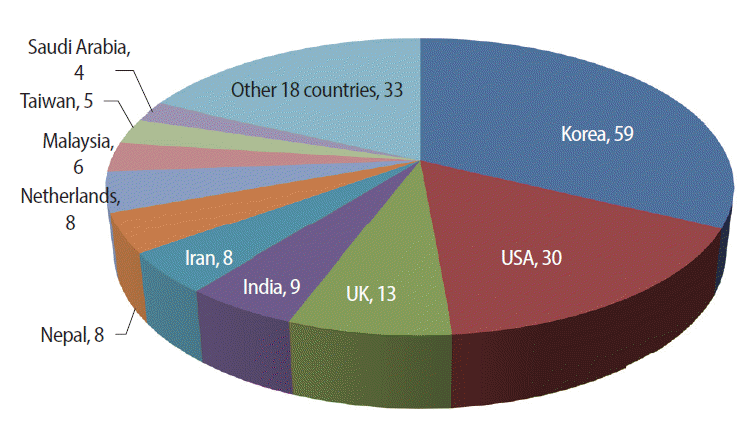Since its launch in 2004, the Journal of Educational Evaluation for Health Professions (JEEHP) has been widely read and cited by worldwide educators in the health professions fields. In the year 2015, the 12th volume was published. As the second editor following first editor Chan-Il Park, a pathologist and top-notch editor, I have done my best to edit this journal superbly and to disseminate its content to the world. I aimed to trace the journal’s position in the worldwide journal network to determine, based on journal metrics, how much it has been promoted during the past 12 years. The brief history of journal’s management is also described. I hypothesize that JEEHP is comparable to international journals, at least within the scope of bibliometrics.
The first JEEHP issue was published in December 2004. The launch of the new journal was suggested and promoted by the second President of the National Health Personnel Licensing Examination Board of Korea, Sang-Ho Baik, an anatomist and great medical educator in Korea. Dr. Baik asked Dr. Park to take the position of editor. Dr. Park, a leading editor, elegantly edited and published first volume containing single issue, which was published in Korean. In 2005, Dr. Park proposed that I take over his job as editor of JEEHP. I accepted his proposal and edited volume two, which also contained a single issue. Although it was possible to collect manuscripts, thanks to financial support for articles from the National Health Personnel Licensing Examination Board of Korea, it was difficult to publish more than one issue per year due to limited manuscript submissions. At the time, few educators in health professions conducted study of educational evaluation in Korea. I decided to change the publication language of the journal to English and to publish it exclusively online in 2006. To my knowledge, JEEHP is Korea’s first online-only scholarly journal without print copies equipped with eISSN in Korea. After changing the language of the journal to English, submissions decreased dramatically; however, because it is now an online-only journal, there is no need to collect manuscripts for regular publication. Any accepted manuscript can be published immediately after its acceptance.
Despite decrease in submissions, potential existed for promotion of the journal to international standing by way of the PubMed Central (PMC, http://pubmedcentral.org) platform, “a free full-text archive of biomedical and life sciences journal literature at the U.S. National Institutes of Health’s National Library of Medicine.” JEEHP could be deposited into PMC by providing PMC XML. For this reason, I began to study PMC XML in 2006, and eventually produced a complete form of PMC XML. The journal was deposited to PMC starting on February 17, 2009, and was also searchable from PubMed. Subsequently, submissions from outside Korea increased, marking 2009 as the year of JEEHP’s new launch as an international journal. Since 2007, its CrossRef XML files have been deposited to CrossRef, assigning JEEHP with a digital object identifier (DOI). Since September 1, 2008, it has been indexed in KoreaMed (http://koreamed.org/) and KoMCI (http://komci.org/). On February 12, 2009, it was added to the Directory of Open Access Journals (http://doaj.org/). On January 2, 2013, it was listed in the CINAHL database (https://www.ebscohost.com/nursing/products/cinahl-databases/cinahl-complete) and with EBSCO (https://www.ebscohost.com/). In September 2013, it began to be deposited to ScienceCentral (http://e-sciencecentral.org/), a unique JATS-based full-text database that provides translation into 80 languages. In December 2015, it was found to be listed in the Emerging Sources Citation Index maintained by Thomson Reuters (http://wokinfo.com/products_tools/multidisciplinary/esci/). These domestic and international databases are windows to the world’s educators, allowing the journal to propagate more widely.
With respect to journal metrics, the following were analyzed based on the journal’s biography and the Web of Science Core Collection database [cited 2015 Dec 25]: number of citable and non-citable articles; number of research articles supported by grants; editorial board members’ countries; authors’ countries; citing authors’ countries; source title of citing articles; impact factor (two year); total citation; and Hirsch index. Analysis methods were the same as those used in previous analysis of other journals [1-3].
Results were as follows: Number of citable articles up to December 25, 2015 was 141; that of non-citable articles was 33 (Fig. 1). Number of research studies or original articles supported by grants was 27 (29.0%) of 83 research articles (Fig. 2). In 2004, editorial board members were from one country, while in 2015 they were from 16 countries on six continents. Authors in 2004 were from one country only and from 22 countries in 2015. The origin countries of authors who most frequently publish articles in the journal were Korea (59), the United States (30), the United Kingdom (13), and India (9) (Fig. 3). Fifty five out of 174 articles were cited at least once by the Web of Science Core Collection database. Authors who cited JEEHP were from 27 countries; of these, the United States (22), Korea (18), the United Kingdom (10), and Canada (10) were top ranking (Fig. 4). Source titles citing JEEHP were from 45 journals. Of these 45, ten sources cited three or more times: Medical Teacher (7), Journal of the Korean Medical Association (7), BMC Medical Education (5), Academic Medicine (5), Nurse Education Today (3), Medical Education (3), and the Canadian Journal of Anesthesia (3) (Fig. 5). Impact factors manually calculated from 2012 to 2015 were 1.300, 0.667, 0.211, and 0.439, respectively. Total citations was one in 2008; it soared to 31 in 2015 (Fig. 6). Hirsch index was five. Publication types of highly cited articles (articles cited five or more times) were reviews (3), research articles (1), technical reports (1), and editorials (1) (Table 1).
I was surprised by these results. Based on metrics, the journal’s growth to international standing is remarkable. I believe that the English-only language policy enacted in 2006 was successful from the perspective of journal metrics and networking. At first, the number of submissions and publications increased dramatically from 2014 although there was a decreased number of submissions at the early stage of language change. In 2015, I received 97 submissions; 31 manuscripts were published, and six are under revision or in press. Acceptance rate was thus 38.1% (in contrast, nine manuscripts were submitted in 2005, all of which were accepted).
The increase to 16 editorial board member countries may have caused the increase in number of author countries to 22 in 2015. The so-called platinum open access policy, which imposes no author-side article processing charge, may also have contributed to variety in author countries. Citation in 27 countries and 45 source titles show the international usefulness of the journal’s content. This may also be influenced by JEEHP’s status as an open access journal indexed in PubMed, PubMed Central, and other international databases. The effect of indexing in PubMed on citation is a known phenomenon concerning domestic journals (those not published by global commercial publishing companies or based in North America or Western Europe)[4].
Impact factor can be calculated using data from 2012. Before that, citation frequency was negligible. The first value from 2012, manually calculated from the Web of Science Core Collection, was 1.300 and in 2015, it decreased to 0.439. This may be a result of the increase in articles in 2014, few of which were cited. The total citation value of 31 in 2015 inspired me, since scientific education is not a rapidly evolving field. I would be delighted if a significant number of archived articles could be used by educators.
The Hirsch index results were somewhat different from the other analyses. Typically, review articles or original articles received the highest citation [1-3]. An editorial on journal policy is included among the highest-cited articles in JEEHP, along with a technical report on the clinical skills test of the Korean Medical Licensing Examination.
What were the important events affecting JEEHP’s promotion to present such excellent metrics results? Introduction of digital standards such as Journal Article Tag Suite XML [5], CrossRef/DOI, CrossMark, FundRef [6], text and data mining [7], open researcher and contributor ID (ORCID) [8], and QR code [9] may have made major contributions to this change [10]. Because researchers and educators often read journal articles via the web nowadays, digital presentation of articles is an essential aspect of journal publishing, and I have typically been an early adopter of digital journal standards. Of course, the most important aspect is the journal content itself; therefore, I am grateful to the contributing and citing authors of my journal for their role in promotion of JEEHP. I also apologize most humbly to the many researchers whose submissions have not been accepted due to lack of reviewers, article amount limits, or insufficient understanding. I dare say that my hypothesis, that JEEHP is comparable to international journals, can be accepted.
Article information
-
No potential conflict of interest relevant to this article was reported.
Acknowledgments
This work is supported by the Hallym University Research Fund (HRF-G-2015-4).
Fig. 1.Number of citable and non-citable articles of Journal of Educational Evaluation for Health Professions from 2004 to 2015 [cited 2015 Dec 25].
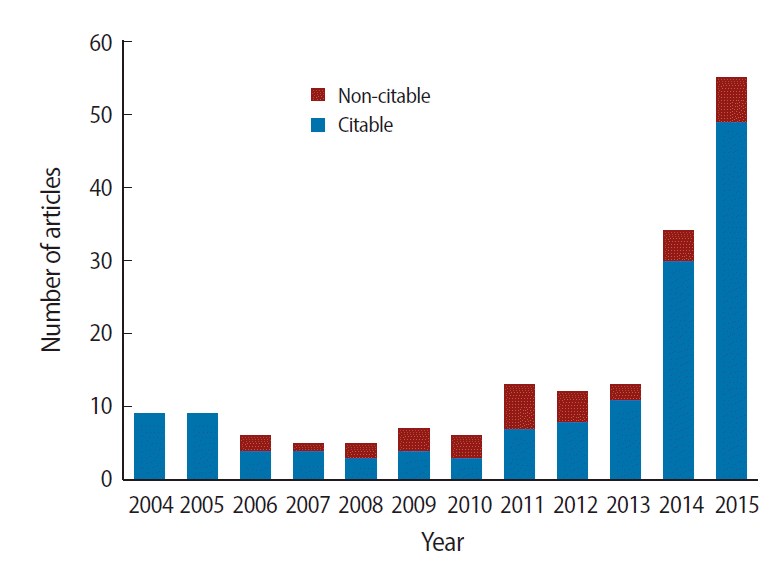
Fig. 2.Number of funded and not-funded research articles of Journal of Educational Evaluation for Health Professions from 2004 to 2015 [cited 2015 Dec 25].
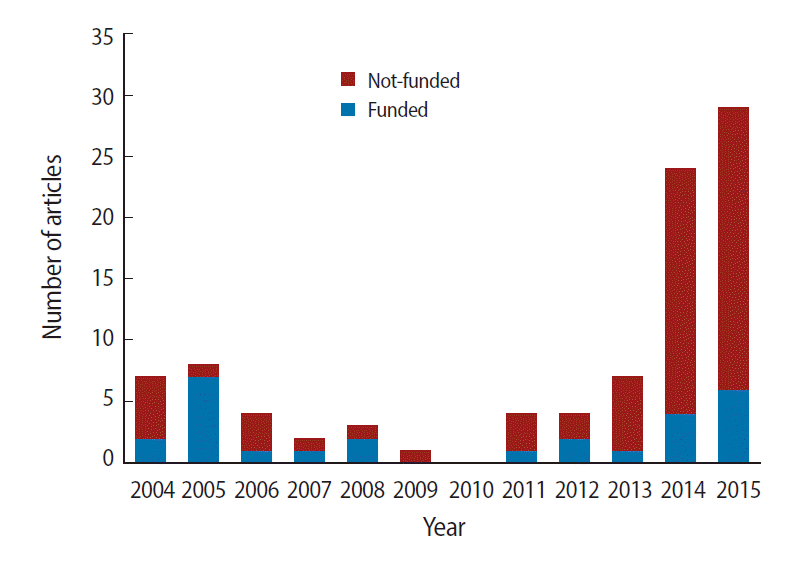
Fig. 3.Number of articles by author’s country of origin in Journal of Educational Evaluation for Health Professions from 2004 to 2015 [cited 2015 Dec 25].

Fig. 4.Number of articles by country citing Journal of Educational Evaluation for Health Professions from Web of Science Core Collection from 2004 to 2015 [cited 2015 Dec 25].
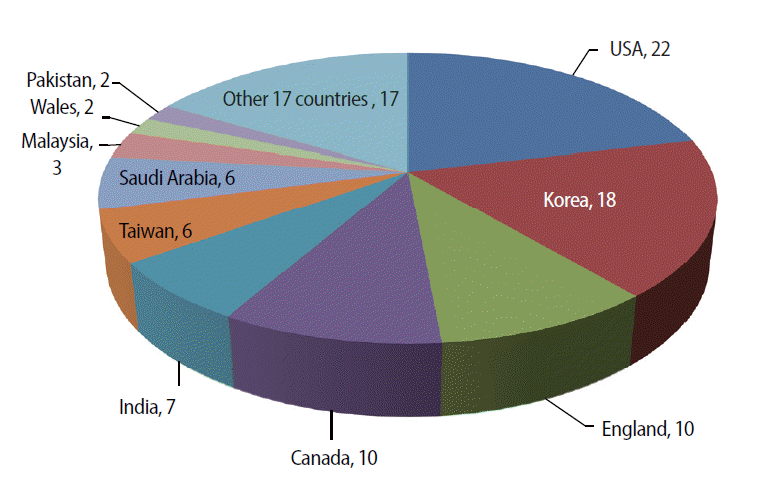
Fig. 5.Source titles of articles citing Journal of Educational Evaluation for Health Professions from Web of Science Core Collection from 2004 to 2015 [cited 2015 Dec 25].
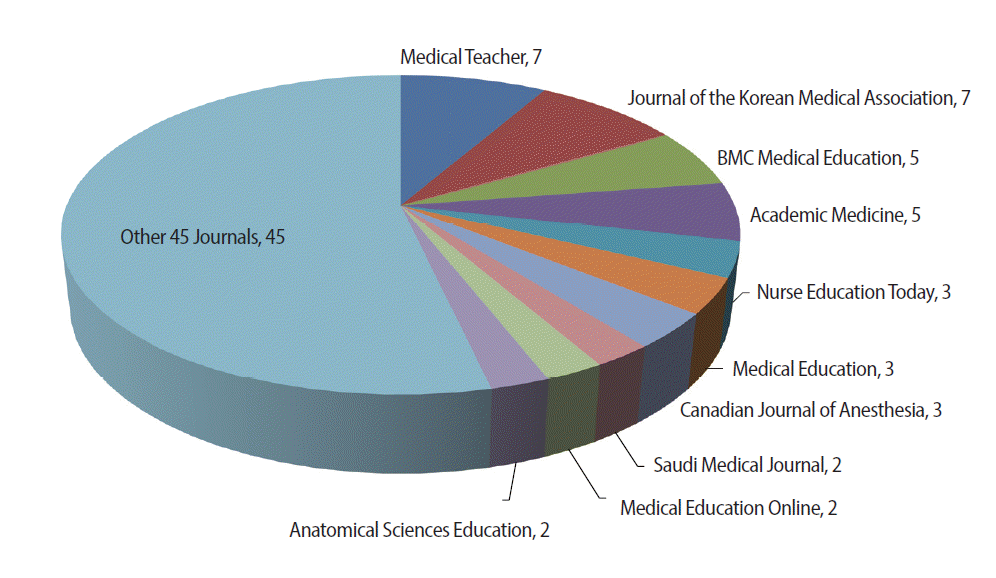
Fig. 6.Total citation of Journal of Educational Evaluation for Health Professions from Web of Science Core Collection from 2004 to 2015 [cited 2015 Dec 25].
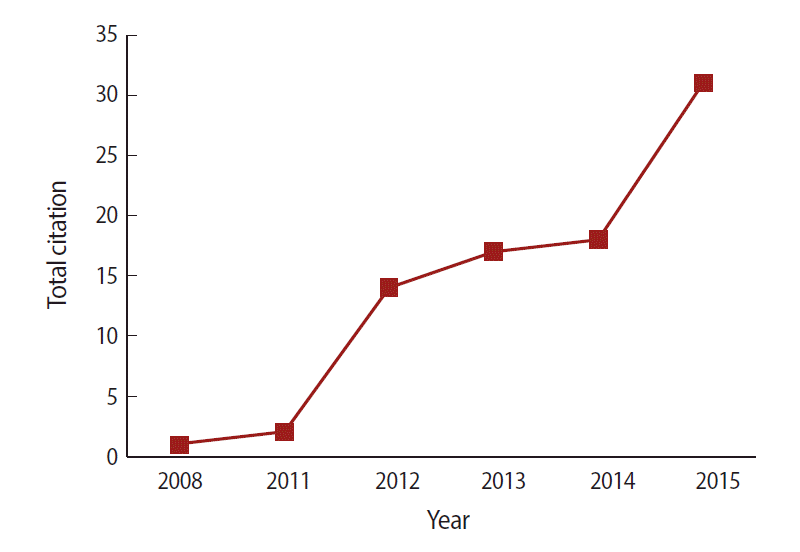
Table 1.Most frequently cited articles and their publication types in Journal of Educational Evaluation for Health Professions, 2004-2015; if at least five articles are cited five or more times in the Web of Science Core Collection [cited 2015 Dec 25], Hirsch index is five
|
Ranking |
Title |
Year |
Article no. |
Publication type |
Citation frequency |
|
1 |
Patient simulation: a literary synthesis of assessment tools in anesthesiology |
2009 |
3 |
Review |
9 |
|
2 |
United States medical students' knowledge of Alzheimer disease |
2013 |
4 |
Research article |
6 |
|
3 |
An overview of ethnography in healthcare and medical education research |
2011 |
4 |
Review |
6 |
|
4 |
Revision of the instructions to authors to require a structured abstract, digital object identifier of each reference, and author's voice recording may increase journal access |
2013 |
3 |
Editorial |
5 |
|
5 |
Introduction and administration of the clinical skill test of the Medical Licensing Examination, Republic of Korea (2009) |
2010 |
4 |
Technical report |
5 |
|
6 |
The future of e-learning in medical education: current trend and future opportunity |
2006 |
3 |
Review |
5 |
References
Citations
Citations to this article as recorded by

- Journal of Educational Evaluation for Health Professions will be accepted for inclusion in Scopus
Sun Huh
Journal of Educational Evaluation for Health Professions.2019; 16: 2. CrossRef - Journal metrics of Clinical and Molecular Hepatology based on the Web of Science Core Collection
Sun Huh
Clinical and Molecular Hepatology.2018; 24(2): 137. CrossRef - How much progress has Blood Research made since the change of the journal title in 2013
Sun Huh
Blood Research.2018; 53(2): 95. CrossRef - The great rise ofIntestinal Researchas an international journal 3 years after its language change to English as evidenced by journal metrics
Geum Hee Jeong, Sun Huh
Intestinal Research.2017; 15(1): 1. CrossRef - The rapid internationalization of Annals of Pediatric Endocrinology & Metabolism as evidenced by journal metrics
Sun Huh
Annals of Pediatric Endocrinology & Metabolism.2017; 22(2): 77. CrossRef -
Clinical and Experimental Vaccine Research's promotion to internationally competitive journal evidenced by journal metrics
Sun Huh
Clinical and Experimental Vaccine Research.2017; 6(2): 67. CrossRef - Promotion ofNeurointerventionto International Journal Based on Journal Metrics
Sun Huh
Neurointervention.2016; 11(1): 5. CrossRef - Journal of Gastric Cancer's Promotion to International Journal from the Perspective of Biliometric Analysis
Sun Huh
Journal of Gastric Cancer.2016; 16(1): 8. CrossRef -
Clinics in Orthopedic Surgery's Evolution into an International Journal Based on Journal Metrics
Sun Huh
Clinics in Orthopedic Surgery.2016; 8(2): 127. CrossRef - Analysis of the suitability of the Korean Federation of Science and Technology Societies journal evaluation tool
Geum‐Hee Jeong, Sun Huh
Learned Publishing.2016; 29(3): 193. CrossRef - What is interesting in the issue 2016 of Journal of Educational Evaluation for Health Professions?
Yera Hur
Journal of Educational Evaluation for Health Professions.2016; 13: 46. CrossRef

















 KHPLEI
KHPLEI

 PubReader
PubReader ePub Link
ePub Link Cite
Cite

